
0 results
Quick reference list of toxic ingredients to avoid. If any of the following compounds are in any of your personal care products, it's time to ditch and switch.
This is a tricky one because it doesn’t appear on labels. It’s formed as a by product of mixing ethylene oxide to other ingredients to make them less harsh. For example, Sodium Laurel sulfate is quite harsh on the skin but when mixed with ethelyne oxide, it becomes less so, creating Sodium Laureth Sulfate. This is commonly found in products containing suds such as shampoos, liquid soaps and bubble bath. This is carcinogenic which means possible cancer causing, also potentially causes organ-system toxicity, and an irritant. Women tend to use several if not more products per day, so the risk of layering products containing this dangerous chemical is serious. Everyone should avoid this and in particular, pregnant women, infants and teenagers should steer clear of products that may contain 1,4 Dioxane. Ingredients to be wary of are PEG usually followed by a number, polyethylene glycol, polyoxyethelene, and ingredients ending in “eth” and “xynol”
How to avoid: Avoid products containing SLS, SLES and PEG followed by a number.
Listed as Aluminum Chlodride, Aluminum Chhlohydrate, Aluminum hydroxybromide. These show up in anti perspirant. It’s a neurotoxin and there has been conflicting data linking it to Alzheimers disease and breast cancer.
How to avoid it : It’s an easy enough one to avoid by switching to a natural deodorant.
This is widely used as a UV filter commonly found in sunscreens, lipsticks, nail polish, hair dye, skin creams. The EWG Skin Deep website rates it a "6"with the highest concern being biochemical or cellular level changes and endocrine disruption.
How to avoid: read ingredients and switch to a sunscreen containing only zinc as it's active ingredient.
This is a by product of bituminous coal and a known human carcinogen. It’s found in anti dandruff shampoos, hair dyes, cosmetics and sometimes mouthwash. Not always visible on the label as sometimes only parts of it are used, not the whole.
How to avoid it: if the label says Coal Tar, put it down and walk away! This is listed as a “10” on the EWG Skin Deep site, 10 being of highest concern. P-phenylenediamine is used in many hair dyes, the darker ones generally containing more than lighter colors.
As a group these chemicals are called Ethanol amines. They are used in a wide variety of household and cosmetic products as emulsifiers and pH balancers. They’re found in mascaras, foundations, blush, eyeshadows, eyeliners, fragrances, sunscreens, lotions, cleansers, hair dyes, household cleaners to name a few. The health concerns here are: Cancer, organ-system toxicity possibly affecting male reproductive health as well as accumulating in the liver and kidneys. Be on the look out for: Diethanolamine (DEA), Triethalomine (TEA), Monoethalomine (MEA), Ethanolomine (ETA)
How to avoid: Check the ingredients list
This is of the highest concern according to the EWG Skin Deep website who gives it a 10/10 score for toxicity. This is another of those hidden chemicals not always listed in the ingredients as it’s released by a number of preservatives. If you think about it, it’s what’s used to embalm dead people… It has been known to be found in nail polish, a wide variety of body and hair care products, hair growth products, antiperspirant. Health concerns are: Cancer, Immune system toxicity, allergen and irritant. Look out for: Formalin, Formic aldehyde, Merthaldehyde, methanal, Methyl aldehyde, oxomethane, oxymethylene. It can also be released by other ingredients such as DMDM hydantion, quaternium-15, diaxolidinyl urea.
How to avoid: Avoid antiperspirant and choose a natural nail polish or at least one that is “3,5 or 7 free”
These metals may appear as contaminants in certain products. Mercury is an active ingredient of thimerosal which is used as a preservative in mascara. Lead has been found in a very high portion of lipsticks on the market. Thimerosal in mascara. Lead acetate can be found in some hair dyes. These metals are both highly toxic and wether ingested or absorbed into the skin can lead to numerous health issues including depression, brain damage, miscarriage, problems with the nervous system. Thimerosal. But unfortunately mercury and lead aren’t normally listed as ingredients themselves because they are contaminants.
In fragrance, phthalates are used as dispersers and to prolong the scent. In nail polish they serve to make it more flexible and chip resistant. Again, not necessarily listed on the label. It may be hiding in a fragrance or perfume. Nail polish, hair products body product may contain phthalates. As well as a slew of household products and plastics. Health concerns are: Suspected carcinogen, endocrine disruptor, meaning they interfere with the production of hormones. DBP has been found to cause anatomical birth defects to baby boys(!!) and has been correlated to lower sperm count and decreased fertility. Everyone should avoid phthalates if they can especially pregnant and lactating women, infants, children, adolescents, menopausal women. Look out for: Fragrance; mostly but not always contains phthalates. Also look for DBP, DEHP, 1,2 benzenedicarboxylate (and variations of), dibutyl/diethyl esther (and variations of).
How to avoid: A proactive thing to do is contact the manufacturer to find out is if the product is phthalate free, or contains no synthetic fragrance
These are cheap preservatives used in most cosmetics to prolong the shelf life of the product. They can be found pretty much in everything from makeup, haircare, skincare to deodorant. (Parabens have also been found in breast cancer tissue) These are believed to be an Endocrine disruptor. Possibly mimicking estrogenic effects. Everyone should avoid these, especially women of child bearing age, infants, adolescents and menopausal women. What to look out for: Methyl/ Propyl/ Butyl/ Isobutyl/ Isopropyl Paraben, Hydrobenzoic acid or hydroxybenzoate or ester.
How to avoid: read the label
This is an inexpensive foaming agent used to cut through oil and is found all over the place. Soap, shampoo, body wash toothpaste, bubble bath baby wash, mascara etc. The biggest concern with SLS and SLES as mentioned earlier is contamination with 1,4 dioxane as well as ethelyne oxide. They are a common skin irritant. May be endocrine disruptors. What to look out for: Sodium lauryl/leaureth sulphate, sodium dodecyl sulphate, sodium salt sulfuric acid PEG lauryl sulphate
How to avoid: read the label
Fragrance is a mixture of natural and synthetic chemicals used to give a product a pleasant smell. Fragrance in and of itself isn’t an ingredient but a collection of possibly hundreds of undisclosed chemicals. Due to “trade secret” laws, companies aren’t required to name what is in “fragrance”. In fact lots of companies aren’t aware of what goes into the said fragrance as the pre-made perfume can come from a separate company. Not to say that absolutely ALL products containing fragrance are harmful, just be prepared to do some research into the products you are using. The most obvious is perfume, but most products used on the body and in the home contain some form of fragrance including your lotions, haircare, skincare and makeup. Health concerns are potentially numerous because of the unknown ingredients and because it can be inhaled, ingested and absorbed through the skin. Some ingredients may be allergens, neurotoxins or skin irritants. Fragrance commonly contains phthalates which are potent endocrine disruptors. Everyone should avoid synthetic fragrance if they can especially infants, pregnant women, adolescents and menopausal women. Look out for: Fragrance, perfume, parfum.
How to avoid: Choose a natural perfume and if unsure contact the manufacturer.
A potent solvent and paint thinner found in nail polishes, nail hardener, some fragrance though it will not be listed. Believe it or not in some dental composites as I found out recently while researching what to get my teeth filled with- but that’s another story! This is a potent neurotoxin, immune system toxicity, it’s a bone marrow toxin, possible link to leukemia and blood cancer, may cause damage to a developing fetus. Everyone should avoid this nasty chemical, especially pregnant women. Be ware of toluene, toluol, methylbenzene, phenylmethane.
How to avoid: Use only reputable nail polish brands and read the labels, choose a 3,5,7 or 8 free polish or a completely natural one. Contact the manufacturer.
Use our Shade Matcher to quickly find the most complimentary shades for your unique complexion, or connect with one of our makeup artists for a personal colour consult.

See your recommendations on the next page.

Check your email for your unique 10% off code
A natural gum extracted from the Acacia Tree.

A soft plant butter obtained from the Karite tree (Butyrospermum parkii)
Melts at body temperature.
Softens and smooths the skin.
Prevents moisture loss.
Shea almonds from the Karite tree (Butyrospermum parkii)

Made from the seed of the camellia japonica plant (also called Tsubaki ) and a long-time essential ingredient in both Japanese and Chinese medicine traditions, camellia japonica seed oil has a great ability to boost collagen synthesis, thus improving the skin’s elasticity.
Known as a natural anti-inflammatory and a great protector of the skin barrier, camellia japonica seed oil reduces the transepidermal water loss, resulting in a decrease in wrinkle formation and fine line appearance.
Skin soothing, moisturising and anti-inflammatory properties.
Helps promote collagen synthesis, retain skin elasticity, reduce the appearance of wrinkles and fine lines.
Camelia Japonica Seed

A medium chain triglyceride derived from coconut oil offering protection to the lipid barrier of the skin to guard against loss of hydration.
Pigment dispersion
Moisturiser
Coconut

Natural replacement for silicones. This creates a barrier to the skin with superior moisturising qualities. Made from renewable, sustainable ingredients using green chemistry.
Moisturising, holding the pigment in place
RSPO certified palm/palm kernel oil and coconut oil.
Castor Bean Oil.

A fine and light oil, carthamus tinctorius (or commonly known as safflower) seed oil, is a natural skin conditioner and lubricant. Rich in linoleic acid and highly moisturising, it is easily absorbed and supports your skin’s natural barrier function. The result is a soft, smooth skin texture.
Known for acne fighting properties
Moisturising
Safflower

A fine oil absorbing powder from the European Beech tree.
Oil Absorbing, blurring effect
Fagus Sylvatica(European Beech)cellulose.
Forms part of an emulsification system binding water and oil to form a cream.
Product stability.
Fatty acids derived for RSPO Palm (Elaeis guineensis), coconut (Cocos nucifera), sugarcane (Saccharum), rape /canola
(Brassica), sugar beet (Beta vulgaris), corn (Zea mays)

A natural emollient made of 100% sustainably-sourced coconut oil fatty acids, coconut alkanes help to lock in moisture into your skin while nourishing it. An effective alternative to silicon, this also aids with pigment dispersion without forming a sticky, greasy film on the surface of the skin.
Fast absorbing and light
Offers a soft silky skin feel
Coconut


This light and non-oily skin conditioning ingredient is a natural emollient alternative to mineral oil and silicone. A natural blend of sustainably-sourced, non-drying coconut alcohol, naturally-derived capric acid and caprylic acid, it is quickly absorbed into the skin, leaving a velvet-smooth, non-tacky skin texture ready for immediate make-up application.


Used as a non-greasy, non-tacky, biodegradable alternative to silicone, ethyl macadamiate is an ester made by blending fatty acids of macadamia oil with ethyl alcohol.
It is naturally nourishing yet because it offers better spreadability than its synthetic counterparts, it doesn’t feel sticky on your skin. This natural emollient offers greater protection and increases hydration and skin radiance.
It also offers better pigment dispersion so make-up application is more efficient.
Skin Radiance
Skin Hydration
Silky Feel
Macadamia integrifolia

Due to the rugged and arid climactic conditions of it's native Mexico, this plant produces wax to protect itself from water loss.
Water repellant
Lustre
Film Former
Candelilla plant
A moisturising and emulsifying emollient used for it's antimicrobial properties.
Antimicrobial
Coconut and/or RSPO certified Palm oil

A plant cell complex derived from the Blue Bird Hibiscus plant, this anti-oxidant stimulates the skin metabolism, slows down the natural oxidation process and reduces the production of free radicals. The result is a visible decrease in wrinkle size and depth, as well as an improved skin tone.
High in antioxidants to repair skin damage and help even skin tone.
Slows down general cell oxidation.
Reduces excessive production of free radicals.
Blue Hibiscus


Sunflower seed oil and made of triglycerides of linoleic acid and oleic acid, it helps to restore the skin’s natural barrier’s protection, resulting in greater hydration and a visibly improved skin texture. Also rich in Vitamin E, this powerful anti-oxidant with known anti-inflammatory properties, repairs, strengthens and soothe the skin
Rich in Vitamin E
Sunflower

A solidified version of olive oil
A mineral used to add colour to cosmetics either on their own or by coating a mica substrate.
Colour Pigment
Iron Oxide

A natural ester derived from moisturising jojoba oil, this non-greasy emollient improves the staying power and stability of pigments on your skin while nourishing and protecting your skin with antioxidants and Vitamin E and B. The natural high oxidative stability of jojoba oil allows a longer efficacy of the formula.
Improve barrier function
Enhance oxidative stability of the product
Moisturising
Simmondsia chinensis (Jojoba seeds)

A compound of the mineral magnesium and stearic acid for enhanced slip and adhesion.
Adhesion to the skin
Oil absorbing
RSPO certified Palm oil and minerals derived from the sea.
A natural alpha-hydroxy acid, thus a great skin brightening and smoothing ingredient, malic acid is found in fruits like apple and pear. Milder than its synthetic counterparts, it offers a gentle exfoliation process and boosts ceramide production. The result is tighter pores, a decreased pigmentation and a reduction of visible lines.

A silicate mineral which is coated with various other minerals including iron oxides to create various effects from pearlescent to matte textures. Aleph chooses to only work with suppliers committed to using ethically sourced Mica.
Offers colour, texture and dimension to makeup.
Muscovite

Ultra fine powder derived from wood used to create a soft focus blurred effect.
Smoothing effect
Blurring effect
Wood pulp
Sustainably harvested and naturally processed from the fruits of the Myrica Pubescens tree. Found in Colombia
Hair conditioning properties
Berries of Myrica Pubescens tree
A long chain fatty acid used for pigment dispersion and moisturisation.
Pigement Dispersion
Moisturisation
Coconut and Palm oil (RSPO Certified)
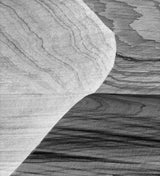
Unique to New Zealand, Totarol is sustainably sourced from the heartwood of recycled Totara trees. With antioxidant properties seven times more effective than Vitamin E, Totarol also has antibacterial properties effective at fighting acne
causing bacteria.
Antibacterial
Soothing, Calming
Antioxidant properties
Reclaimed Totara wood

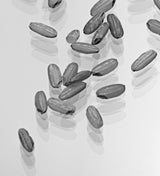
Part of a patented combination of ingredients set to guard the skin against the damaging effects of urban pollutants and blue light.
In combination with other ingredients:
Guards against blue light and urban pollutants
Rice


Traditionally used in Chinese medicine and the Ayurvedic tradition of India, this natural antimicrobial acts as strong antioxidant and free radical scavenger and helps to protect
the elasticity of the skin.
Preservative booster
Helps to protect elasticity of the skin
Red Raspberries

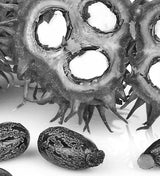
A thick plant oil high with a low molecular weight to penetrate the skin easily for added skin softening.
A skin soothing and softening
Castor Bean Plant


Extracted from the highly fragrant wood of the Santalum Album tree and considered one of the most sacred oils, Sandalwood has been used since ancient times in religious ceremonies, for cosmetic and perfume.
Sandalwood oil helps balance and soothe the skin as well as aiding in toning and firming the skin.
Santalum Album Tree

One of the earths most abundant minerals, in cosmetics used as a powder providing high oil absorption.
Oil Absorption
Mattifying
Silky skin feel
Silica

Derived from the fatty acids from the milk thistle plant, silybum marianum ethyl ester is a sustainably-produced dry oil rich in Omega 6 fatty acids. It protects the natural skin barrier function and helps to soften the skin.
Strengthens skin barrier and helps retain optimum moisture levels.
Creates a silky feel and holds pigment to the skin.
Milk Thistle


An organic cold pressed oil extracted from the seeds of the Jojoba shrub. Technically not an oil but a wax, Jojoba has a very similar molecular profile to human sebum.
Penetrates deep into the skin to help balance sebum production.
Simmondsia chinensis (Jojoba Seeds)

A sugar alcohol used as a humectant

Derived from the Australian superfood Kakadu plum, the richest source of Vitamin C known, terminalia ferdinandiana seed oil is a powerful anti-oxidant and collagen synthesis booster. It naturally regenerates your skin and helps your skin to fight free radicals, slowing the appearance of skin ageing, soothes and brightens, resulting in a more even skin tone and a smoother texture.
Antioxidant
Emollient
Humectant
Skin protecting
Kakadu Plum Seed Oil

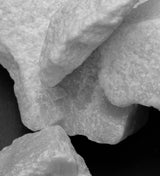
Creates a hydrating barrier to the skin preventing water loss while nourishing the skin. Cocoa butter also smells heavenly!
High in antioxidants, hydrating and nourishing to the skin and provides a luxurious skin feel.
Cocoa Butter is obtained from the fruit of the Cacao tree (Theobroma Cacao)

A naturally occurring white mineral used in cosmetics to provide opacity, brightness and pigment.
Colour Pigment
Ability to refract light
Titanium Dioxide
Vitamin E used as an antioxidant
Antioxidant properties to prevent oxidation of lipids
Sunflower Oil
A palm-free alternative medium chain triglyceride derived from castor bean and coconut, Tripheptanoin is a non-sticky and non-greasy natural emollient.
A formula enhancer, it helps other ingredients to penetrate the different layers of the skin faster and feels light on the skin.
Nourishing to the skin while assisting pigment dispersion
Coconut and Castor Oils
Coenzyme Q 10 is a potent antioxidant used by the mitochondria of the cell to help produce energy and function optimally.
Neutralises free radicals
Reduce the appearance of fine lines and wrinkles.
Evens out skin tone, and helps fade and prevent dark spots by blocking out tyrosinase, a catalyst in the production of melanin.
Microbial fermentation
This superfood grown in New Zealand contains a host of benefits for the skin including antioxidants like Vitamin E, as well as high concentration of omega 3s to maintain moisture.
Grown in New Zealand and up cycled from the food industry, Kiwifruit seeds are cold pressed to extract a 100% natural oil with an extremely high concentration of Alpha Linolenic Acid.

Also known as Arctic Winged Kelp. This brown algae is made up of a network of elastic fibres helping it survive in extremely strong tidal pressure waters.
Reduce the appearance of fine lines and wrinkles.
Firming and toning.
Helping reduce the accelerated aging protein Progerin in aging cells.
Arctic Winged Kelp

Sourced through a group of cooperatives of Argan production with the intention of providing employment to women in rural areas. This extract from the Argan Fruit Pulp has been produced to help plump and redensify the skin over the long term.This ingredient is organic, Cosmos and Ecocert approved.
To boost type 1 Collagen production
Fights against "adipocytes ageing"
Argan Fruit Pulp
Used in traditional Chinese medicine for a variety of benefits, this antioxidant rich plant has been shown to offer skin benefits.
Boosts hyaluronic acid synthesis
and increases elasticity
Astragalus Root
A rich butter produced by the fruit of Amazon Native Murumuru tree.
Murumuru butter is rich in medium- and long-chain fatty acids, such as lauric acid and myristic acid, which can help to restore the skin’s moisture barrier.
Fruit of the Murumuru tree, native to the Amazon region of Brazil.
A gentle yet powerful plant-based alternative to retinol. Bakuchiol acts to improve skin texture, reduces fine lines, brighten skin tone, and support collagen production and elasticity.
Improves skin texture, reduces fine lines, brightens skin tone, and supports collagen production and elasticity.
Psoralea corylifolia plant
Preservative
A combination of Biotin and Tripeptide-1 this string of amino acids helps delay hair follicle senescence, facilitate hair fixation in dermal hair follicles to prevent hair loss helping lashes grow stronger and longer.
Improves eyelash length and strength
Synthesised from Amino Acids
A component used in the coating of a substrate to achieve the desired effect of certain colour pigments.
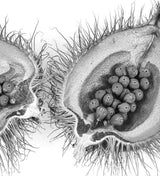
Commercially known as Annatto, the Bixa Orellana plant has been used since Mayan times for it's culinary and many healing properties. In this instance, the seeds are cultivated, sundried and ground to release a potent extract that delivers matifying and pore refining properties.
Decrease sebacious gland activity
Decrease pore size
Maintain Skin Hydration
Mattify the skin
Bix Orellana Plant

A natural, palm-free fatty alcohol used as natural structuring agent and secondary emulsifier.
Improves stability and texture
Naturally derived from waxes found in plants from the Cabbage (Brassica) family.
Texturising agent, improves the feel on skin or lips
Hydrogenated Palm Oil (RSPO) and Palm Kernel Oil
A glass type material used as a substrate coated with Iron Oxides, Titanium Dioxide or Silica to create colour and sparkle.
Reflective and Pearlescent and irridescent.
Mineral - Silica
Humectant
A mineral used to absorb oil.
A glass type material used as a substrate coated with Iron Oxides, Titanium Dioxide or Silica to create colour and sparkle.
Reflective
Pearlescent
Irridescent
Mineral - Silica
Wax which exudes from the leaves of the Brazilian Palm tree.
Film Former
Water repellant
Brazilian palm tree known as ‘Copernica Cerifera’, also referred to as the "Tree of Life".
Mamaku, New Zealand Native Black Fern Extract contains unique biomimetic biopolymers
which it uses as defensive and adaptive mechanisms to survive and
thrive in its environment.
Together with NZ Red Seaweed creates a synergistic effect of
immediate lifting and tightening of the skin.
Hydrating, Lifting and Firming
Mamaku, New Zealand Native Black Fern Extract
Preservative
Synthetic
An light, skin conditioning emollient.
Forms part of the active ingredient system
Coconut and/or RSPO Certified palm oil
A component used in the coating of a substrate to achieve the desired effect of certain colour pigments.
Part of a patented combination of ingredients set to guard the skin against the damaging effects of urban pollutants and blue light.
In combination with other ingredients:
Guards against blue light and urban pollutants
Organic Soy Bean
A Clay mineral used to deliver a silky skin finish.
Silky, Velvety texture.
Mineral/Nature Identical
A natural surfactant
A component used in the coating of a substrate to achieve the desired effect of certain colour pigments.
Enhances keratin production while conditioning the lashes, preventing break off allowing for longer, stronger lashes.
Conditioning and Strengthening
Synthesised from Amino Acids
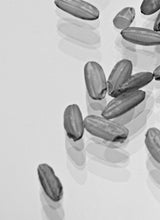
Upcycled and sustainable, Rice Bran Wax is extracted from the bran layer that has been removed to create white rice.
Adds structure to the formulation.
Water repellant.
Rice

Part of a patented combination of ingredients set to guard the skin against the damaging effects of urban pollutants and blue light.
In combination with other ingredients:
Guards against blue light and urban pollutants
Rice
Part of a patented combination of ingredients set to guard the skin against the damaging effects of urban pollutants and blue light.
In combination with other ingredients:
Guards against blue light and urban pollutants
Glycerin and Stearic acid (Palm Free)
Preservative
The high quantities of oleic acid found in this oil give it exceptional skin softening properties. Traditionally Sweet almond oil has been known to assist in the healing of skin conditions such as psoriasis and eczema.
Regenerating, soothing, and moisturising properties
Almonds
An emulsifier derived from 100% natural and renewable feedstock.
Emulsifier
Coconut and/or Palm oil (RSPO), Castor oil
Synthetic Vegan Red colour
Synthetic Red Pigment
A synthetic red pigment
New Zealand Native Red Seaweed contains natural biopolymers that are known to form a fishnet like matrix that can help hold
water molecules, while also acting as a structural
scaffold to tighten the skin.
Developed using Clean Chemistry to ensure ultimate bioavailability of its active compounds.
Hydrating, Plumping, Tightening
Wildcrafted New Zealand Red Seaweed
An ancient adaptogenic plant popular in Chinese herbalism for centuries, and valued for its high levels of antioxidants to protect the skin from environmental stressors and free radicals. This berry extract has also been revered for its ability to visibly revitalise skin tone and texture by significantly improving cutaneous firmness, resilience, and elasticity.
Increases the skin cells’ energy level and vitality
Helps the skin to adapt to the impact of pollutants, free radicals and mechanical forces
Significantly increases skin elasticity
Visibly improves fine lines
Improves skin tonicity and smoothness
Schisandra berries
A biopolymer produced by an aerobic fermentation process.
Fermentation of sugars with strains of Sclerotium rolfsii.
Ethically produced and Sustainably refined to produce a skin softening butter.
Skin smoothing and softening
Seeds from Karite tree
Shea almonds from the Karite tree (Butyrospermum parkii)
Preservative
Hyaluronic Acid is a humectant capable of holding 1000X its weight in water. As we age the natural HA produced by our bodies declines contributing to moisture loss, increasing the signs of aging.
Hydrating, plumping
Byproduct of the bacterial fermentation of Corn, Wheat and Yeast Extract.
Sodium sulfate a simple inorganic salt and not to be confused with surfactant sulfates such as SLS commonly found in personal care items. Sodium sulfate is used in one of our ingredients to aid with the drying of the resin mix and not a surfactant. This appears at less than 0.001% in the final product.
Is known as the Toothache plant due to its numbing properties when chewed. In skincare it’s known as a source of a Phytotensor Molecule which has Vasorelaxant and antioxidant activities, beneficial for their lifting effect as a fast-acting muscle relaxant while also having a positive effect on the skin’s collagen network.
Stimulates, reorganizes and
Strengthens the collagen network
Antioxidant
Muscle Relaxing aiding in the visible reduction of fine lines and wrinkles
From a natural and renewable source, this olive derived emollient mimics a lipid found in the skin offering additional nourishment and moisture.
A component used in the coating of a substrate to achieve the desired effect of certain colour pigments.
Plant derived sugar

A lipid composed of glycerin and hydroxystearic acid.
Helps colour payoff.
Castor Oil

Purified water
To allow for evaporation in order to set the product. Or sometimes found in very small amounts as part of an ingredient system.
Water
Texturising agent
Polysaccharides produced by an aerobic fermentation process.